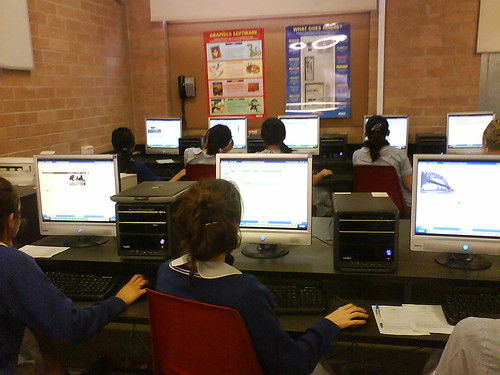Just wanted to share this Voicethread that some of my students did (there are still more kids to add their voices yet). In my Year 7 art class we were looking at the work of contemporary Australian aboriginal artist Sally Morgan, and the students had to examine a painting called My Grandmother’s Country. We had quite a long discussion about it in class and looked at some of the symbolism used in the painting. The students then had to write a response to the work.
In the past, this task is usually done purely as a text-only task… it gets discussed in class and they then do the writing at home. I thought I’d try using Voicethread instead, because it allowed them to access the artwork from home, to zoom in to see detail, and to hear me re-explain what they needed to do with it. (I know, I know, YOUR students never forget anything you tell them in class, but mine sometimes do).
They were a bit shy about leaving voice comments at first, so instead they wrote a written response as usual, but many said it was really useful being able to hear the task explained again from home. After they submitted the written task, which I thought they mostly did pretty well, I got them to record some of their responses as audio files which we uploaded to Voicethread along with their photo. This ability to upload audio to Voicethread instead of having to record it directly onto the page is a feature of a Voicethread Pro account, which is available to educators at no cost. I found it made it so much easier to collect the audio comments, especially since this class is not in a room with computers. I use my MacBook Pro to record their audio to QuickTime, convert it to MP3 using QuickTime Pro, snap a photo using Photobooth and then I do the uploading after class or whenever it’s convenient.
Anyway, for what it’s worth, here are some of their observations so far… if you want to leave an encouraging (moderated) comment for them that would be wonderful…
[kml_flashembed movie="http://voicethread.com/book.swf?b=15007" width="600" height="450" wmode="transparent" /]
It will be interesting to see if the quality of their speaking and recording changes once they realise that they have an audience…
PS: Thanks to @nzchrissy via @alannahk for pointing me to the solution to embedding these Voicethreads into the blog like this. Nice!

 I’m sitting in class at the moment with a group of Year 10 students as they do the NSW Board of Studies exam for computing skills. For those that
I’m sitting in class at the moment with a group of Year 10 students as they do the NSW Board of Studies exam for computing skills. For those that